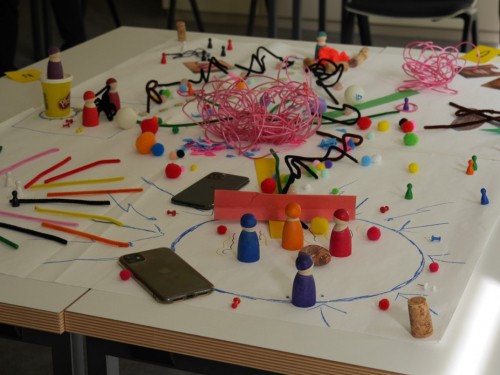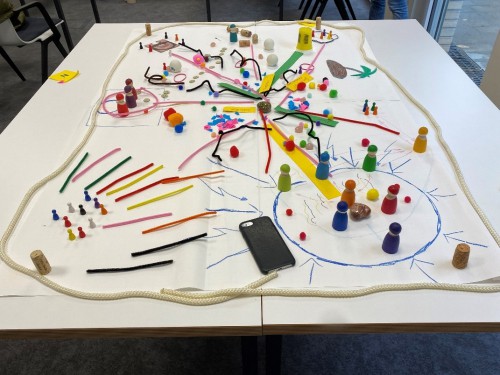Consulting, although in the area of soft factors, has been a familiar core service of our company for business development for many years. Even as a boutique consultancy, we ask ourselves the provocative question from time to time in the context of strategy development:
Do we still need “consulting” or can it go away? And if it is still needed, in what shape or format?
Yes, that is our latest conclusion. Enabling, the new consulting.
How consulting was understood for a long time
There they were, those gray silverbacks and the large gaggle of motivated freshly graduated master’s students +, usually with excellence exams, who were certainly moving in the upper echelons of the companies. They were given ample freedom, conducted many interviews and collected valuable information in the organization at lightning speed. They routinely matched these with the concepts and competencies of their own consulting firm and documented them in a well-ordered and activating manner on slide decks prepared in a manner suitable for management. In manageable project periods. When they were gone, what remained was usually an excellent concept that had been coordinated with the C-level. Evaluated, provided with an action plan and “ready for take off”. Period.
These times are not over yet. Even today, this approach is still widespread.
That was really “expensive” and only low efficient
The slightly pointed undertone results from my own consternation. First of all, from the perspective of an employee who experienced how her knowledge, insights and experience were incorporated into the Big Concept without citation of the source and were reported without comment as the competence of the consulting firm.
And later, from the perspective of a consultant who came in after the big consulting firms were no longer there to support the levels below the C-level, to understand what was left behind or to work through and implement what was outlined in the concepts. Many a time we were the umpteenth consultancy that struggled to design what others had thought up or mixed for others. It was a miracle when a suitable added value emerged. With the many non-participants. Apart from the fact that, in addition to a high degree of demotivation, it cost vast sums of money.
If these concepts were ever implemented at all. We don’t even want to know how many of these high-end analyses and strategies were buried somewhere, in drawers in the past and in file folders today.
First it should then save the change management
The first attempt to get a bit of sustainability into it was to expand the idea of turning “stakeholders into participants”. Stakeholders should no longer only be asked in (stakeholder) interviews, but should also be involved in the development and implementation of solutions. This is where change management came into play. A large number of change projects were set up, most of them running in parallel, in which the added value and benefits of the high-end concept were explained. Naturally supported by powerful promoters. At least in theory, because with all the operational workload there was/is actually no time for this. Supported by a project management designed internally or by an external consultant and many Gantt charts. So a lot was done to explain and design how to make the concept make the transition from paper to everyday life. This was (at least economically) not bad for us. This was not a bad thing for us (at least from an economic point of view), because in addition to designing and implementing the concept, we also had to take care of change and project management. The external consultants continued to add value. And the so-called stakeholders became only indirect participants in the whole thing.
Even agile approaches did not bring the desired success
In the meantime, agility conquered the stage and now the sprints were supposed to fix it. Classic project management was given a new (admittedly pointy-headed) suit. The mood of those involved temporarily rose somewhat. Becoming a participant was within reach and finally, one’s own competence could be expanded a bit. How inspiring and beneficial. Finally, new faces came into play – Agile Coaches. They talked a lot about how to shape VUCA, the added value of vision and mission, and how to create team spirit. And they had funky tools in their little suitcase, e.g. retrospectives or techniques from Management 3.0. Great, Brought new motivation. And it was good that there were the consultants who created the deliverables in the meantime. Please don’t misunderstand: we are of course also Agile Coaches and continued to make our revenue with the externally delivered value.
However, it was really all just the same wine in new bottles.
Enabling, the new consulting
I don’t know whether we were driven by the fact that we no longer wanted to be primarily the extended workbench (although this will always be part of our service portfolio) or whether the entrepreneurs in us no longer see this incredible use of resources or – and perhaps this is it – we have seen that the greatest potential, namely that of the stakeholders, is not being used at all, but we decided some time ago: Enabling, the new consulting.
Since then, we have concentrated on enabling those affected, i.e. internal clients, whenever we create a deliverable for them. I.e. we apply what we have only talked about with the many approaches of the past. We co-create with our clients and share all our knowledge. Aware and with the intention to make ourselves superfluous at least with regard to this design. In this way, we make it possible for added value to be created directly and immediately by everyone concerned. In this way, those affected become participants and co-creators, and the personal and corporate competencies are strengthened.
With the perspective of creating much more.
The positive effect, which we have already experienced many times, is: the motivation of all participants increases and also their innovative power. Collaboration becomes tangible and spreads its effectiveness. And all parties have a whole lot more fun.
We call this enabling, the new consulting. And we believe this is the future.
You shape the future.
It works well with us.
created by: Eva-Maria Danzer


